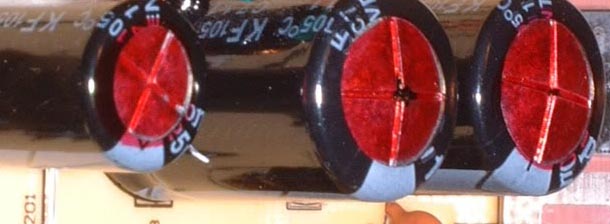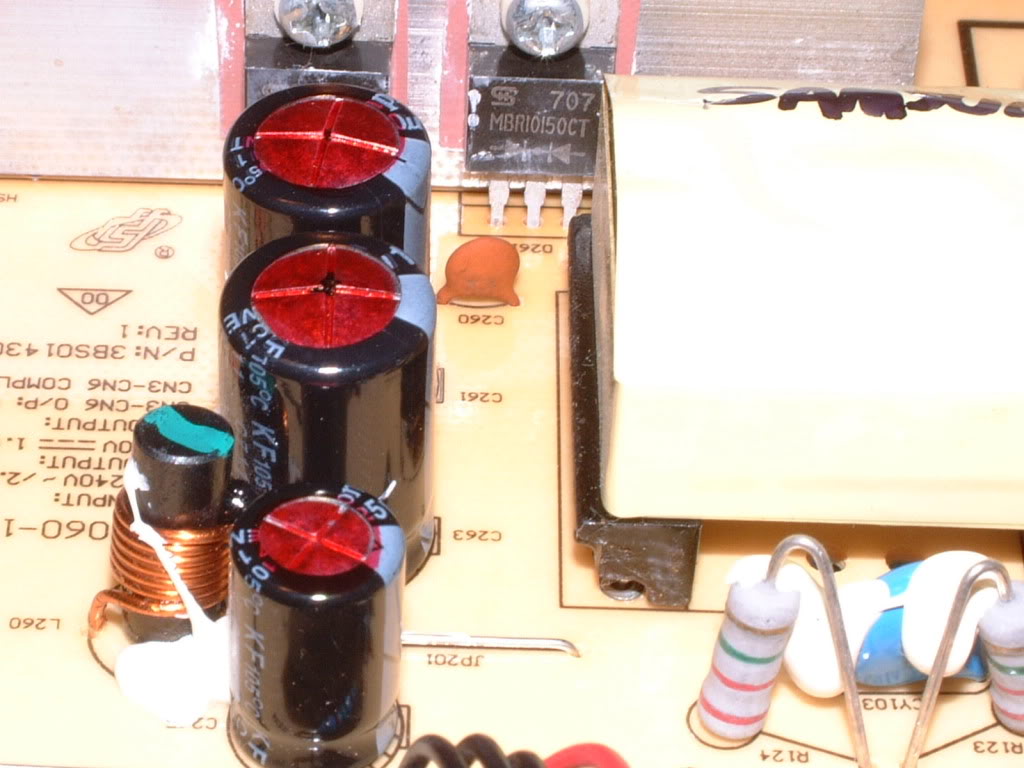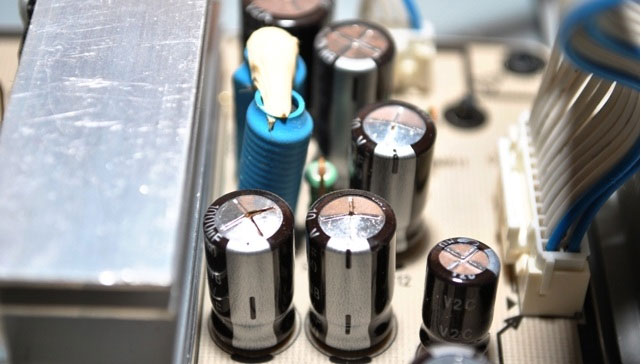Capacitor issues galore.
This weekend I serviced one more Samsung 205BW monitor dealing with a very infamous capacitor issue. One which has caused some attention and lawsuits similar to dell and other companies dealing with. A crappy Chinese capacitor company "CapXon" handing out a bunch of mid-range low-temperature caps inside of a confined space where there can be up to 4 or more high voltage back-lights going resulting in the insides of your monitor cooking and respectfully your capacitors overheating as well.
I guess I am just posting this because I don't want to see LCD monitors go needlessly into a landfill all because of a stupid part that costs a few dollars at the very most for capacitors! And someone with mediocre soldering skill. (Ladies and Gentlemen, please don't use solder braid on a power board, you'll destroy the traces. Get a solder sucker. A good quality one!)
Picture showing what a blown capacitor looks like on a default Samsung power board. You'll note the two in the middle (typically 820uf 25v capacitors) are the ones that are bulging or popped, leaking corrosive material all over the cap or board giving that 'rusted out' look to it all.
Capacitor substitution.
A month prior I service 3 more Samsung monitors this very way. And I will say that in a default capacitor variety pack an 820uf capacitor is not all that common, especially at 25v) So what does any good tech do? They substitute.
Original Samsung LCD capacitor configuration running parallel on the power board traces:
2x 820uf 25v capacitors
My Substituted configuration for the Samsung displays:
1x 1000uf 25v capacitor
1x 680uf 25v capacitor
NOTE: The Samsung board also had 3x 330uf 25v caps which we replaced as well on all of the boards I serviced because I have little to no respect to CapXon.
I did the substitution because I don't have 820uf caps. Since both caps are on the same trace rail then as long as the total UF of both caps is within +/- %10 error then the replacement will be fine 2*820uf=1640uf - 1000uf+680uf=1680uf - In a power board environment it is considered acceptable and thus the replacements on all four monitors have been working flawlessly since the repair.
Now it's disclaimer time.
Disclaimer: You should never substitute for other types of capacitors unless your absolutely sure that you know what you're doing. Always check your power against an oscilloscope to ensure the ESR is within tolerance to drive your device prior to hooking everything back up. I need to put this warning in here because if I don't I will probably enrage some electronics people.
Picture above - 32" Samsung flat panel television with multiple bad 1000uf 25v and 35 volt capacitors.
I have also taken the liberty of fixing a few of the larger screen televisions that were at a friend's Italian Restaurant. The picture above is the approximate representation of that power board. but it appears that Samsung has had a really long track record of capacitors exploding. on the 32" that we worked on, we replaced
- 1 - 2200uf 10volt capacitor
- 4 - 1000uf 35volt capacitor
- 2 - 1000uf 25volt capacitor
- 1 - 3300uf-10volt capacitor
After replacing all of them the flashing red light remained solid which ended up saving a football night at her restaurant. We are glad Samsung used a more standard capacitor for their higher-end displays. Yes, they were still under warranty but Samsung wanted to exchange them which would take days to accomplish. Days of no TV mean thousands of business dollars lost to this restaurant so in their mind voiding the warranty was well worth it. And if it meant paying for $10 worth of caps and an hour of my time. Versus hundreds of dollars. Even better!
A side-note we have been also fixing dells and Acers which experience similar problems. Mostly CapXons however there were a few power boards that were refurbished the had swollen caps and they were Rubicons. Which goes to show that you can even destroy the good quality caps in these things because of their amazingly poor ventilation.
Getting capacitors is easy, you can go through mouser, or digikey, or even Ebay so long as you watch what you are buying (try not to get caps from china that do not have a brand-name behind them as they -could- be the crap tin-and-paper caps) .
What about polymer capacitors for use on power boards?
After looking through a lot of forums about this I've come to the conclusion that this is a bad idea. Liquid Capacitor to Polymer substitution even on a motherboard is highly experimental. To do so on a power board is to do so at your own risk! The main reason why you don't see polymer capacitors for power boards is the voltages are much higher than being on a motherboard and it's hard to find polymers above 16+ volts.
Your best bet is to get some name brand liquid capacitors that have a low ESR value and can withstand higher temperatures (above 105+C) to ensure a long life with your monitor.
Final thoughts.
Apparently the proper term I should have used for this article should have been "Capacitor Plague" as pointed out by the Wiki. However, capacitor failure continues to happen to this day and I am going to have to disagree with Wiki that this plague really ended. In some cases, it's because a company wanted to pump out a product as cheaply as possible so they take a chance on one of these newer capacitor manufacturers which have no prior history. Other times it's because of piss poor engineering where they seal their monitor up so tight that there's practically no room for the heat to escape. Heat can destroy even the best of caps as we've pointed out earlier in this article. Just know that sometimes the quality of the capacitor doesn't matter if the environment it's housed in is poorly thought out.
We hope this helps you out a little.




Why do some Aluminum Electrolytic Capacitors show DOUBLE the uf rating? That is with removing them from the circuit too!
Most confusing for a hobbyist!
This article was helpful. Thanks for taking the trouble to write it. Cheers!
Same issue with CapXon caps on the power board. Even the big ones rated 420v 100uF look smoked but this TV actually did put out enough smoke the owner thought it was going to burn her house down. Same TV also has two slave power boards manufactured by LG Phillips using caps by a company called SanWHA LT that are mounted weird that look blown rated 35v 470uF. Ever see this company's caps? Are they also known crap?
I've heard of a company called "Samwha" which is a korean based company that bought a lot of electronics manufacturing that Samsung sold off. Samwha has gotten poor reviews from people because often times it's what is found on the power boards of flat panels like yours. And it's pretty amazing that 100uf 420v filtering cap exploded. Out of the 100+ monitors and flat panel TVs I have repaired I think I only replaced that giant one twice. In both cases it was due to almost nonexistent ventilation from the RF shield. Which heat will destroy even the best of caps.
Looks like its time to eject them all and put in a fresh set of caps. only way to be sure. I'd replace that 100uf one first just to verify that there's no other damage like say the step down transformer before putting the rest on.
I just got done fixing a Samsung monitor and opening one ViewSonic monitor. Both have numerous bulging CapXon caps at the output side of the main power supply. The Caps I pulled out of the Samsung were mostly 820 or 220uF. The ViewSonic has 1000 and 220uF. There is a bunch of the ViewSonics at my workplace that have or will likely be trashed because of this issue. At least a few other people have learned that they can be fixed relatively easily. Glad to share my experience and read others'.
I'm having the same problem, will not turn on,red light flickers
capacitors all look good, none leaking or bulging.
could the capacitors still be bad or is it something else?
46'' samsung LN46A650A1FXZA.
It seems your model of Samsung is known for having the click on/off issue due to how many youtube videos are out there. Capacitors may still be bad even if they do not show signs of leakage or breaking as they fluid inside may have partially dried up. Not enough to break or budge the seal but possibly lower then %10 tolerance which can be enough to trip the power circuit.
It couldn't hurt replacing them as capacitors tend to be very cheap. take note of all Uf and voltage values and replace them all at the same time. Get some quality caps such as Rubycons or Panasonics with a low ESR value. I wouldn't worry about the 1-2 giant 400v caps on the power board. Just all of the smaller ones.
That's what I did for all of the Samsung monitors at the restaurant.
Good luck and hope it works out!
Cool was looking up that cap brand and found your site. Samsung Monitor and HP desktop power supply had them and they are cooked. Really bad brand.
Note that the 820µF you swapped with a 1000µF is most likely a filtering cap for a PWM switching circuit driving the backlight. Sure, the value is not a lot off, but the change does alter the frequency response of the filter, so it's possibly leaking a tiny bit more ripple in its output.
Again, the change isn't a drastic one, but this is something that should be kept in mind. Some people will assume that any larger value cap is okay... which it is for a generic mains input cap, but definitely not for filters used after switching regulators or diodes, as they're tuned to a specific high frequency.
Apparently CapXon capacitors has been an issue in other monitors as well. Wikipedia details an epidemic of Taiwanese capacitor failures due to the wrong electrolyte formula. I'm currently waiting on a batch of caps from Mouser to fix a Sceptre 32" TV (12 total, most ruptured), and expect the problem to be fixed.
As far as solder removal is concerned, the cheap Radio Shack desoldering iron does a passible job but you need extra heat for RoHS (lead-free) assemblies.